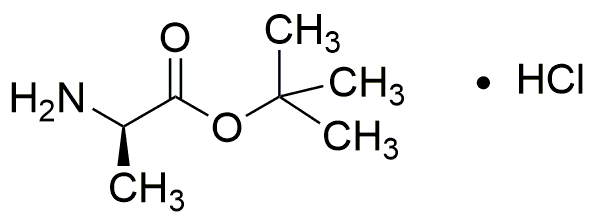D-Alanine tert-butyl ester hydrochloride is widely utilized in research focused on:
- Peptide Synthesis: This compound serves as a valuable building block in the synthesis of peptides, which are essential in drug development and biological research.
- Pharmaceutical Formulations: It is used in the formulation of various pharmaceuticals, enhancing solubility and stability, making it easier to develop effective medications.
- Biochemical Studies: Researchers employ this compound to study amino acid behavior and interactions, providing insights into metabolic pathways and enzyme functions.
- Cosmetic Applications: Due to its properties, it can be incorporated into cosmetic formulations, improving skin hydration and texture.
- Food Industry: It is also explored as a flavoring agent or preservative, contributing to the enhancement of food products while ensuring safety and quality.
General Information
Properties
Safety and Regulations
Applications
D-Alanine tert-butyl ester hydrochloride is widely utilized in research focused on:
- Peptide Synthesis: This compound serves as a valuable building block in the synthesis of peptides, which are essential in drug development and biological research.
- Pharmaceutical Formulations: It is used in the formulation of various pharmaceuticals, enhancing solubility and stability, making it easier to develop effective medications.
- Biochemical Studies: Researchers employ this compound to study amino acid behavior and interactions, providing insights into metabolic pathways and enzyme functions.
- Cosmetic Applications: Due to its properties, it can be incorporated into cosmetic formulations, improving skin hydration and texture.
- Food Industry: It is also explored as a flavoring agent or preservative, contributing to the enhancement of food products while ensuring safety and quality.
Documents
Safety Data Sheets (SDS)
The SDS provides comprehensive safety information on handling, storage, and disposal of the product.
Product Specification (PS)
The PS provides a comprehensive breakdown of the product’s properties, including chemical composition, physical state, purity, and storage requirements. It also details acceptable quality ranges and the product's intended applications.
Certificates of Analysis (COA)
Search for Certificates of Analysis (COA) by entering the products Lot Number. Lot and Batch Numbers can be found on a product’s label following the words ‘Lot’ or ‘Batch’.
Numéro de catalogue
Numéro de lot/série
Certificates Of Origin (COO)
This COO confirms the country where the product was manufactured, and also details the materials and components used in it and whether it is derived from natural, synthetic, or other specific sources. This certificate may be required for customs, trade, and regulatory compliance.
Numéro de catalogue
Numéro de lot/série
Safety Data Sheets (SDS)
The SDS provides comprehensive safety information on handling, storage, and disposal of the product.
DownloadProduct Specification (PS)
The PS provides a comprehensive breakdown of the product’s properties, including chemical composition, physical state, purity, and storage requirements. It also details acceptable quality ranges and the product's intended applications.
DownloadCertificates of Analysis (COA)
Search for Certificates of Analysis (COA) by entering the products Lot Number. Lot and Batch Numbers can be found on a product’s label following the words ‘Lot’ or ‘Batch’.
Numéro de catalogue
Numéro de lot/série
Certificates Of Origin (COO)
This COO confirms the country where the product was manufactured, and also details the materials and components used in it and whether it is derived from natural, synthetic, or other specific sources. This certificate may be required for customs, trade, and regulatory compliance.

